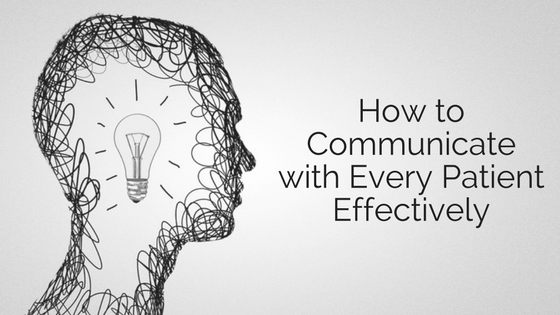personality styles

“The single biggest problem in communication is the illusion that it has taken place.”
– George Bernard Shaw
It’s no secret that good communication is the key to success in business, and in life. However, too often in the middle of a busy day at your practice, communication can break down. According to Pamela Ballou-Nelson, RN, MSHP, PhD, PCMH CCE for the MGMA, “For too long the focus has been on fixing patients yet there is a significant body of research that suggests that provider and staff behaviors (communication styles) are equally responsible for shortcomings in patient activation.”
Failing to communicate well with a patient will not only lead to a poor patient experience, but it can actually cost your practice money. When communication breaks down with a patient the result is low health literacy on their part, which means extra time and cost for your practice in dealing with unnecessary phone and in-person follow up.
The key to good communication with patients is to communicate in a way that resonates for them. Every person’s communication style is different, and is often linked to personality styles. According to Maslow’s Psychological Model for Human Behavior there are four primary personality and communication styles. Knowing how to identify them, and changing your communication style to match that of the patient, will improve your engagement. It can also result in a better experience and possibly even better health results for your patients.
Read on for a brief discussion of the different personality and communication styles and download our free Personality Assessment to learn your style today! (Plus get a handy reference guide to use at your practice).
Results-Oriented
The results-oriented communicator is easy to spot, and is often wrongly assessed as being rude or impatient. They can appear impatient or argumentative, speak quickly and forcefully, and often want to just get to the point. Match their pace and provide information quickly. Don’t take offense, just be firm and give them the answers they are seeking succinctly, outlining their options and asking for their decision. The patient will appreciate your respect of their time and that you were able to answer all of their questions with authority. Remember, the healthcare system is confusing for most patients and you are often the smartest person in the room. Be the expert they need and it will guarantee a satisfactory patient experience.
Socially-Oriented
On the complete opposite side of the spectrum from results-oriented communicators are the socially-oriented. This patient is warm and friendly and will want to chat about themselves (or anything else for that matter!) Return their enthusiasm and rapid pace, and be empathic and upbeat to make a connection. But be careful, this patient can cause delays in your practice, so while you should let them talk sometimes you need to direct the conversation.
Process-Oriented
Patients who seem uninterested or short with you are likely process-oriented. As communicators they are quiet and unemotional, are not fond of small talk, and they use facts and logic to make decisions. They may not ask many questions but they are still looking for information from you in order to make the best decisions about their health, so give plenty of information and logical evidence. Be reserved and wait for them to respond, they may appear to not be listening but they are likely just “processing.”
Relationship-Oriented
It has been our experience that the majority of people within the healthcare industry are relationship-oriented, so these patients are probably very easy for you to communicate with. They are cooperative, helpful and will wait for you to explain everything. Build rapport and match their warm and friendly tone and slower pace. Acknowledge their feelings and uncertainty and offer support, and be sure you don’t push.
Once you know what to look for, and make an effort to match the communication styles of your patients, you will be amazed at the outcome of your conversations! Maybe changing the way you connect will not guarantee that the patient will retain everything you say, but it will result in a positive experience for them and keep them coming back to your practice!
Learn your personality style, and how to recognize others. Download the personality assessment here, and the style descriptions here and start connecting better!
For more on how to create a better connection with your patients, watch our Patient Collections 101 webinar on demand! 
Take this article with you! Click here for a printable version.
Written by Ali Bechtel, Digital Marketing Manager for RMP
This information is not intended to be legal advice and may not be used as legal advice. Legal advice must be tailored to the specific circumstances of each case. Every effort has been made to assure this information is up-to-date as of the date of publication. It is not intended to be a full and exhaustive explanation of the law in any area, nor should it be used to replace the advice of your own legal counsel.
